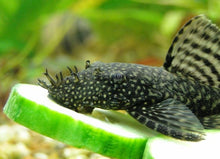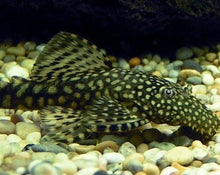Guaranteed Secured Checkout
Ancistrus is a genus of nocturnal freshwater fish native to freshwater habitats in South America. These fish are very common in the aquarium hobby where they are known as bristlenose catfish.
The Bristlenose is a great tank cleaner and we at Melbourne Tropical Fish believe that this is a must have for every tropical fish community aquarium. This fish is absoloutely brilliant in cleaning algae off your glass aquarium. This is one of the main reasons this fish is so common in-home aquariums. They are great algae eaters and will help keep algae levels to a minimum.
They are a very peaceful and generally mind their own business. Male Bristlenose can be combative with other males if there is limited space or caves. They are suitable to live with most kinds of fish but consideration should be taken into suitable water parameters of tank mates.
While Bristlenose eat a wide variety of algae, it is highly recommended that their diet be supplemented with algae wafers. They will greatly benefit from driftwood in your aquarium snacking on the microflora and microfauna that grow on its surface.
Bristlenose catfish are a fantastic addition to most tropical fresh water aquariums.
· Species – Ancistrus sp. Albino
· Common Name – Albino Bristlenose Catfish
· Origin – South America
· Diet – Herbivore
· PH Range – 6.5 – 7.8
· Temperature – Tropical 26°c – 28°c
· Breed Type – Egg Layer
· Current Size – approximately 3cm (Grows to approximately 15cm)
· Sex – Un-sexed
Breeding
This is one way of spawning Bristlenose catfish (Ancistrus dolichopterus). Different breeders have their own favorite tips and tricks, and this method is only one of several successful ways of spawning Bristlenose catfish.
One of the easiest ways of getting a breeding pair is to purchase a group of small Bristlenose catfish and let them form their own pairs. You can for instance get 4-6, roughly 1 inch long, young ones and raise them in the same aquarium. It is virtually impossible to sex young Bristlenose catfish, but if you purchase at least four specimens you have a decent chance of getting at least one of each sex. As the Bristlenose catfishes grow older, it will be possible to distinguish their sex. The males will develop bristles around and on the snout. Bristlenose catfish is not an aggressive species and you can let them grow up with a wide range of other peaceful fish species.
Before spawning Bristlenose catfish, you may want to move them to a breeding aquarium to avoid eggs and fry from being eaten by adult fish. The breeding aquarium can be quite small; many breeders use 10-15-gallon aquariums. You should however keep in mind that it is harder to keep the water quality up in small aquariums. A sponge filter will be of great aid, ideally one with netting or marbles that will prevent fry from getting trapped. The breeding aquariums should be well decorated and included sheltered spots. You can for instance use driftwood. The Bristlenose catfish is known to appreciate short PVC tubes as spawning sites, and including such items is therefore a really good idea. An airstone is necessary to keep the oxygen levels high enough.
Keep the water temperature around 23-27 degrees Celsius when spawning Bristlenose catfish. The pH-value should be neutral or slightly acidic, from pH 6.5 to 7.0. The ideal water hardiness is 4-10 dGH. Regular water changes are important, especially after spawning.
When spawning has taken place, you will be able to see big clusters of yellow or orange eggs at the spawning site. The female can now be removed. The male will stay around the spawning site to fend of attackers and fan fresh water over the eggs. You can see him use his ventral and pectoral fins to constantly provide the offspring with fresh and well oxygenated water. The eggs hatch after roughly five days. You now that hatching is imminent when you see the eggs darken somewhat.



